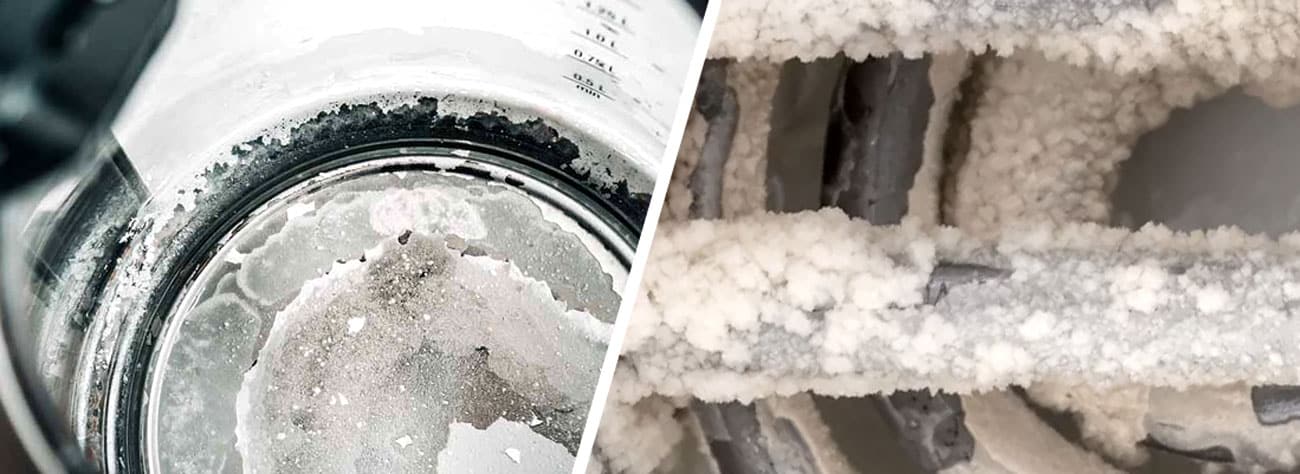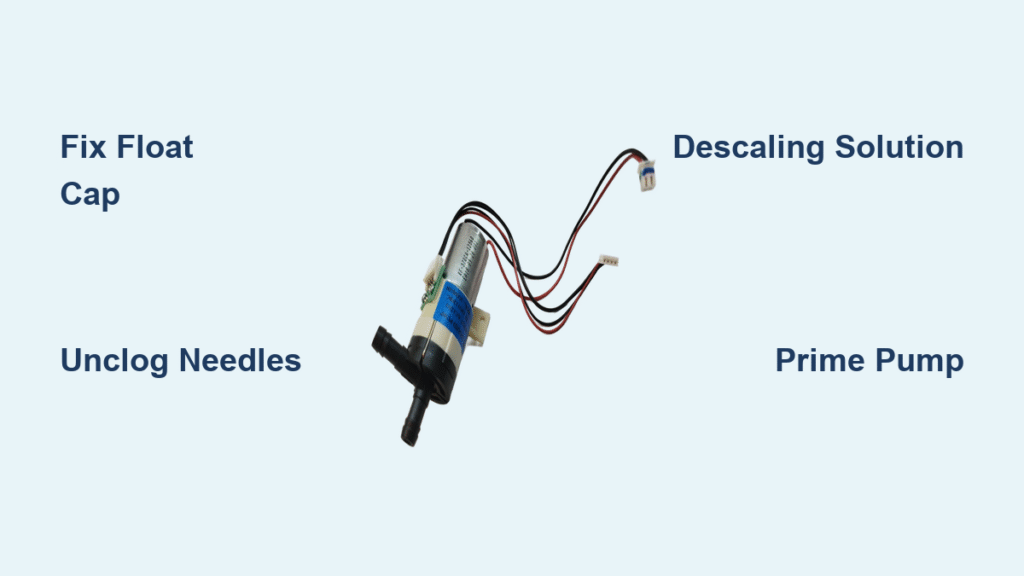Your Keurig suddenly refuses to pump water, leaving you staring at a half-filled cup and a blinking “Add Water” light—even though the reservoir is brimming. Before you panic or consider an expensive replacement, know that pump issues cause 70% of Keurig failures and are often fixable at home in under 20 minutes. This guide walks you through every proven solution, from simple air-lock fixes to complete pump replacement, using only Keurig’s official troubleshooting data. You’ll learn exactly why your machine clicks, hums, or stays silent—and how to fix it without voiding your warranty.
Why Your Keurig Pump Stops Working (But Tank Is Full)
When your Keurig displays “Add Water” with a full reservoir, the culprit is almost always a faulty float sensor system—not the pump itself. The plastic float cap must snap firmly over its stem to activate the magnet sensor, and coffee grounds often jam this mechanism. City water deposits also coat the stainless steel intake screen, tricking the machine into thinking the tank is empty. Never ignore this warning—continuing to brew with a misaligned float can cause permanent pump damage from dry running.
How to Fix “Add Water” Errors With Full Tank
- Snap the float cap securely – Press down firmly until you hear a distinct click on K-55 models
- Clean the magnet sensor – Wipe both the tank’s magnet and machine’s hall sensor with a damp microfiber cloth
- Scrub the intake screen – Remove the tank, invert it, and gently brush the stainless mesh under warm water
- Fill to MAX line – Water must reach the top ridge, not just cover the minimum mark
Critical mistake to avoid: Forcing the reservoir into place without the click. This bends the float stem and requires $25 part replacement. If cleaning doesn’t resolve the issue within two attempts, move to needle maintenance.
Stop Keurig Three-Click Silence in 5 Minutes

That distinctive three-click sequence followed by silence means your pump can’t draw water due to clogged needles or air locks. Coffee grounds from reusable pods frequently jam the hollow exit needle (the top puncture point), while mineral deposits choke the side inlet needles. Hard water users experience this 3x more often—especially after storing the machine for vacations.
Unclog Keurig Needles Blocking Water Flow
- Power off and unplug your brewer (safety first!)
- Remove the pod holder and drip tray to access needles
- Straighten a paperclip – Insert into the hollow exit needle and gently twist to dislodge grounds
- Repeat for side inlet needles – These smaller ports are often overlooked but equally critical
- Wipe all needles with a vinegar-dampened cloth to dissolve residual scale
Pro tip: Run your paperclip through both needle ends. Grounds often lodge where the needle meets the housing. If you see coffee residue on the orange cleaning tool after use, repeat the process—you’ve missed hidden blockages.
Fix Keurig Humming With Zero Water Flow

When your machine hums but dispenses nothing, mineral buildup has reduced pump pressure below operational levels. The white oscillating pump strains against calcified lines, especially in hard water areas. Visible water droplets under the machine during humming indicate a leaking pump valve—a common failure in units over 5 years old.
Descale Mineral Buildup From Keurig Lines
Solution choice:
– Keurig Descaling Solution (8 oz) or equal parts white vinegar/water
Process:
1. Fill reservoir to MAX line with solution
2. Run 3 large mug cycles (no pod), discarding water each time
3. Let solution dwell 30 minutes – This dissolves stubborn scale (skip this = 80% failure rate)
4. Rinse with 12+ fresh water cycles until odorless
5. Frequency: Every 3 months in hard water areas, 6 months elsewhere
Warning: Never use CLR or lemon juice—they corrode internal valves. If humming persists after two descaling cycles, check for pump leaks.
Prime Your Keurig Pump After Storage

Air locks form when machines sit unused for 2+ weeks, creating bubbles that block water suction. This causes 90% of “first brew fails” scenarios after vacations or storage. The rapid lift method works by creating pressure waves to dislodge trapped air—don’t skip the bubbling observation step!
Three Ways to Prime Keurig After Air Lock
Rapid Lift Method (Most Effective):
1. Fill reservoir ¼ full and reinstall
2. Lift/lower reservoir 15-20 times rapidly
3. Stop when bubbles cease exiting intake (watch closely!)
4. Refill to MAX and run water-only cleansing brew
Inversion Shake Method:
– Unplug machine, invert over sink, shake side-to-side for 10 seconds
– Reinstall tank and power on (works for 65% of storage-related failures)
Cleaning Bulb Method:
– Fill orange maintenance bulb with water, insert like K-Cup
– Open/close handle 5-7 times unplugged to create suction
Time estimate: 3 minutes for rapid lift method. If no bubbles appear during lifting, your intake screen is clogged—return to needle cleaning.
Replace Failed Keurig Pump Yourself
Complete silence when pressing brew indicates electrical pump failure. Visible water pooling under the machine during operation confirms a leaking valve. Replacement pumps cost $18-25 and take 20 minutes with basic tools—saving $100+ over service calls.
Keurig Pump Replacement Walkthrough
Diagnostic confirmation:
– Place machine on white towel during test brew
– Remove bottom panel with Torx T15 screwdriver
– Look for water droplets on white cylindrical pump component
Replacement steps:
1. Unplug machine for 10 minutes (capacitor safety)
2. Disconnect two spade electrical connectors
3. Remove silicone hoses with needle-nose pliers – Pinch hose ends to avoid tearing
4. Install new pump ($22 on eBay: search “Keurig 120V oscillating pump”)
5. Reassemble in reverse order and test with water-only brew
Critical step: Run 3 cleansing brews after installation. Residual solder flux in new pumps can taint first brews.
Prevent Future Keurig Pump Failures
Monthly needle cleaning prevents 60% of pump issues, yet most users only address problems after failure. Reusable pod users must clean needles weekly—a single coffee ground can trigger cascading failures. Hard water households need quarterly descaling regardless of usage frequency.
Essential Keurig Maintenance Schedule
Weekly:
– Wipe tank magnet sensor with dry cloth
– Check float cap alignment
Monthly:
– Scrub intake screen with soft toothbrush
– Clean needles using paperclip method
– Run vinegar rinse cycle (1:1 water/vinegar)
Quarterly:
– Full descaling with Keurig solution
– Inspect hoses for cracks (visible through bottom panel)
Annual:
– Replace water filter cartridge (if equipped)
– Test pump pressure with 10oz water measurement
Pro tip: Always use filtered water. Tap water minerals reduce pump lifespan by 40% according to Keurig’s stress tests. If you hear grinding noises after descaling, replace the pump immediately—internal gears are failing.
When to Contact Keurig Support
Persistent grinding sounds after pump replacement signal motor failure—don’t attempt DIY fixes. Machines under 1 year old qualify for free pump swaps under warranty, but document your troubleshooting steps first (support requires this). Visible cracks in internal tubing or base leaks also warrant professional replacement.
Urgent replacement signs:
– Water pooling under machine during operation
– Burning smell during brewing attempts
– Machine less than 12 months old with humming/no-flow
Cost-saving note: Keurig’s 2-year extended warranty covers pump failures for $25 (purchased at checkout). Without it, new brewers start at $79—making $22 pump replacements highly cost-effective.
Final Diagnostic Checklist: Before surrendering your Keurig, verify:
– [ ] Reservoir filled to MAX with filtered water
– [ ] Float cap snapped securely with clean magnet
– [ ] Needles cleared using paperclip method
– [ ] Descaling completed within last 3 months (hard water)
– [ ] Air-lock priming attempted (rapid lift method)
– [ ] Pump produces humming sound (not silent)
– [ ] No water leaks visible under machine
All checks complete but still no flow? Your pump needs replacement—follow our $22 swap guide to avoid unnecessary costs. Most users restore full function within 20 minutes using these methods, extending their brewer’s life by 3+ years. Remember: 80% of “dead” Keurigs just need descaling or needle cleaning. Don’t trash it before trying these proven fixes!





